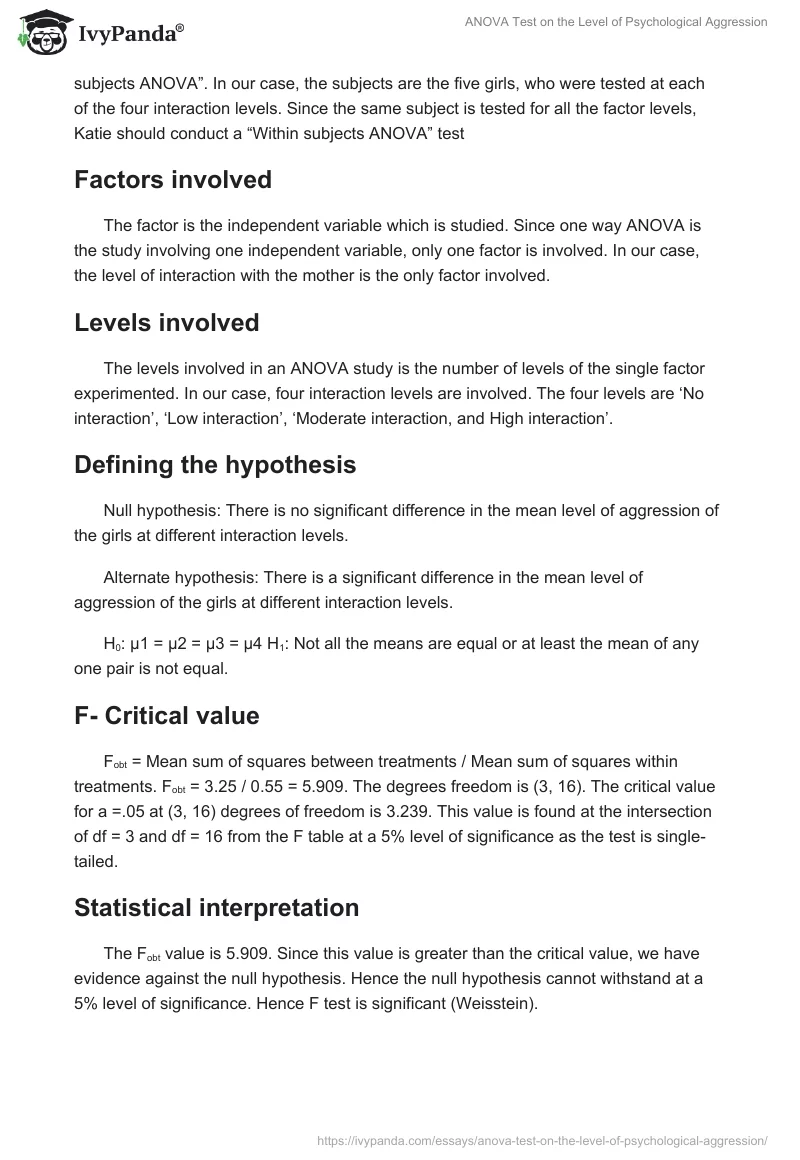Introduction
In this assignment, we are analyzing the population means of a dependent variable at various levels of an independent variable using one way ANOVA test. The data are obtained from Katie who is researching adolescent girls. The data is about the level of aggression of the girls at four interaction levels with their mothers. Five samples are identified by Katie and the research is conducted. The ANOVA test aims to determine the influence of interaction level over the aggression level.
Testing Population Means using one way ANOVA
Independent and dependent variables
One way ANOVA statistical technique is used to test the means of the samples where only one independent variable is involved. This technique consists of separating the total variability in a set of experimental results into components associated with the different sources of variability (Freund, 1999). In our case, two variables are involved. One of the variables is the level of interaction of a girl with her mother and the other variable is the level of her aggression. The level of interaction of a girl with her mother is the independent variable and the level of aggression is the dependent variable. Here the level of aggression is assumed to be dependent on the level of interaction with the mother.
Between subjects or Within subjects?
When the subject is applied to different levels of the independent factor, the study is known as “Within subjects ANOVA”. When the subject is applied to only one level of the independent factor and compared with other samples, the study is known as “Between subjects ANOVA”. In our case, the subjects are the five girls, who were tested at each of the four interaction levels. Since the same subject is tested for all the factor levels, Katie should conduct a “Within subjects ANOVA” test
Factors involved
The factor is the independent variable which is studied. Since one way ANOVA is the study involving one independent variable, only one factor is involved. In our case, the level of interaction with the mother is the only factor involved.
Levels involved
The levels involved in an ANOVA study is the number of levels of the single factor experimented. In our case, four interaction levels are involved. The four levels are ‘No interaction’, ‘Low interaction’, ‘Moderate interaction, and High interaction’.
Defining the hypothesis
Null hypothesis: There is no significant difference in the mean level of aggression of the girls at different interaction levels.
Alternate hypothesis: There is a significant difference in the mean level of aggression of the girls at different interaction levels.
H0: µ1 = µ2 = µ3 = µ4 H1: Not all the means are equal or at least the mean of any one pair is not equal.
F- Critical value
Fobt = Mean sum of squares between treatments / Mean sum of squares within treatments. Fobt = 3.25 / 0.55 = 5.909. The degrees freedom is (3, 16). The critical value for a =.05 at (3, 16) degrees of freedom is 3.239. This value is found at the intersection of df = 3 and df = 16 from the F table at a 5% level of significance as the test is single-tailed.
Statistical interpretation
The Fobt value is 5.909. Since this value is greater than the critical value, we have evidence against the null hypothesis. Hence the null hypothesis cannot withstand at a 5% level of significance. Hence F test is significant (Weisstein).
Decision
Katie should conclude that there is a significant difference in the mean level of aggression of the girls at different interaction levels. She may analyze that any other random effects cause significance. She may identify another set of samples and can do the same research. She can do pro hoc tests to find the existence of significance in particular pair and find that which level of interaction causing the significance.
Conclusion
We have learned to do an ANOVA test to analyze the underlying population means. Inferential statistics provide us a practical and simpler way to analyze real-world situations. ANOVA is an important part of inferential statistics. The main limitation of ANOVA is that the individual significance between the mean is not determined. Only the overall significance is determined. A pro hoc test may overcome this difficulty.
References
Freund, E.f. (1999). Mathematical Statistics: 6th edition. Boca Raton: Prentice Hall International.
Weisstein,W. ANOVA from MathWorld–A Wolfram Web Resource. 2010. Web.


